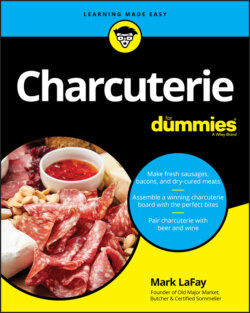Читать книгу Charcuterie For Dummies - Mark LaFay - Страница 35
Temperature control
ОглавлениеAn important factor in controlling the growth of bacteria is proper temperature control. Did your parents ever yell at you to shut the fridge door? My folks did. Probably more so because it caused the fridge to run and use up electricity. But the reality is that spoilage of food happens more quickly at warmer temperatures. That’s because bacteria like to grow when the conditions are warmer.
When processing meat, you want to keep your proteins as cold as possible throughout the process. This will result in a higher-quality product, as well as a safer product. When you are storing meat for processing, you want to store it as close to the freezing point as possible without freezing it. When processing, you want to keep your meat mixtures cold, but this can be difficult when cutting, grinding, stuffing, and so on because of the time the meat is out of refrigeration, coupled with the added friction that comes with grinding and stuffing.
Several years ago, Dr. Bruce Tompkin presented the results of a study, titled “The significance of time-temperature to growth of foodborne pathogens during refrigeration at 40–50°F.” These results showed that you can safely process pork, chicken, and beef at temperatures above 60 degrees Fahrenheit and still be safe. However, it isn’t ideal for producing a quality product. So, to be safe and to ensure the best results, you should use a digital temperature probe such as the one shown in Figure 2-5.
Photo by David Pluimer
FIGURE 2-5: Temperature probe.
When you start handling meat, take the temperature of the meat and jot it down. When you are done working with the meat, record the temperature and the time again. Be sure to keep the temperature below 45 degrees Fahrenheit at all times.
